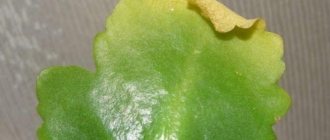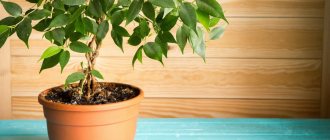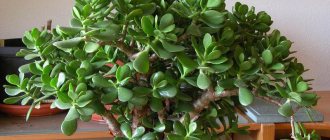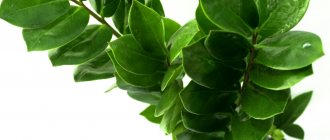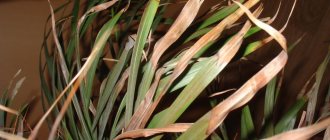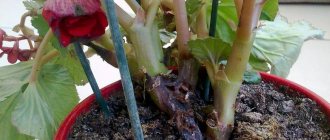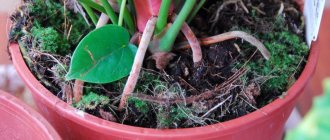Calathea attracts the attention of many gardeners due to its unusual appearance and bright greenery. With proper care, the plant will delight others with its beauty, which can outshine other species. Diseases in calathea are common, since the flower is very demanding to care for. At home, only experienced gardeners can grow the plant well. Calathea, leaves dry around the edges, what to do and how to avoid this problem - this question is asked by many flower lovers. Caring for the calathea flower at home, diseases, their treatment and prevention is the topic of this material.
Why can a plant get sick?
If we talk about a houseplant called calathea, diseases and pests can appear on it only due to improper care. This is precisely what experienced flower lovers who successfully grow various varieties never cease to repeat.
Calathea is a perennial plant up to 1.5 m high
First of all, attention should be paid to watering. Excessive soil moisture, cold or hard water are factors that can negatively affect the quality of flower growth and development. After watering, there should be no drops left on the leaves of the plant, as this is not always beneficial.
The composition of the soil also plays a significant role. Oily and rotten soil can harm the growth of calathea. The cause of rotting is almost always excess liquid that is retained in the soil due to poor drainage. If moss, mold or fungus appears on the surface, they should be removed immediately.
Another name for calathea is prayer flower or praying grass.
The condition of the flower is also reflected in the correctly chosen pot. A small container will result in slower growth. A pot that is too wide and high also negatively affects the life of the plant.
Leaves can dry out due to lack of lighting or high temperature in the room. Moreover, each plant variety requires compliance with certain rules.
Fertilizers play a special role - they must be applied according to a certain schedule, in the proportions specified by the manufacturer. When using folk remedies as fertilizers, mineral complexes must be added in much smaller quantities.
Note! An overdose of nutrients is just as harmful as a deficiency.
Causes of leaves curling and drying
The main reasons for this condition of the plant include the following:
- dry air or draft in the room;
- location of the flower near heating devices;
- insufficient care;
- wrong location.
If the room where the flower is located is not humid enough, the edges of its leaves will dry out.
In the cold season, it is not advisable to place the plant near heating devices. You can save the situation with the help of wet expanded clay placed at the bottom of the pot. In summer, you need to spray the flower with warm water several times throughout the day.
Calathea crocata is a light-loving plant, but does not like direct sunlight. Its leaves are too sensitive and can get burned. This causes their edges to dry out. Sunlight and heat promote the evaporation of moisture from the soil and from the plant itself.
If you decide to place a pot of calathea in a room, you need to choose a place where direct sunlight will not reach. The plant is afraid of drafts. Therefore, you should not place a flower pot near windows that open frequently.
Appearance of the plant
By appearance, you can determine the cause of a plant disease:
- If the leaves curl and rise up, there is not enough moisture in the soil. If they are down, then the reason is the opposite - there is a lot of water in the soil. It is possible that the soil is heavy, which is why the roots do not get enough air. Calathea should be watered when the soil is semi-dry. But there should not be too much moisture.
- If the new leaves that appear immediately dry out at the edges, their lower parts always have a yellowed appearance, this is due to dry air. In summer, Calathea rufibarba needs a draft, but there is no need to place it in direct sunlight. If its leaves, even unblown ones, dry out and turn yellow, then the plant should be placed under a lamp with artificial daylight. Otherwise, the death of the flower is inevitable. It is easier to care for species with glossy leaves than those with velvety leaves, but all calatheas need greenhouse conditions.
- If parts of the plant turn yellow, it may be due to the wrong pot. It shouldn't be too big. The soil should be light. The roots of the plant must be freely located in the soil so that air can flow there. They should be lightly sprinkled on top, otherwise moisture will be retained in the soil, which will lead to waterlogging. After transplantation, the calathea should be covered with polyethylene for a short time until the plant takes root. It is also necessary to fertilize the flower regularly.
- If clear crystals form on the back of the leaves, it is honeydew. The cause of the disease is a sharp change in temperature throughout the day. You need to try to prevent this from happening and keep the flower in conditions of humidity and heat that are favorable for it.
- If the stems of the leaves rot and turn black, and they themselves turn yellow and dry, this is Fusarium wilt. The cause of the disease is excess moisture in the soil. In this case, saving the flower is useless.
It cannot be treated; it must be thrown away so that other plants do not become infected. - If the leaves are covered with a white coating on the back side, it is a spider mite. The pest settles on the entire plant. As a result, the flower grows poorly and small, light spots appear on the leaves. As the colony grows, the spots merge, the shoots curl and dry out. In this case, the web characteristic of a tick may not exist. A sick flower must be urgently isolated from healthy ones and the air humidity must be increased. It should be treated with special means (Aktara, Fitovern, etc.), strictly following the instructions. The same product can be used to treat other plants for preventive purposes.
There is a very beautiful ornamental plant, which, first of all, attracts with its leaves, or rather, with the fancy patterns on them. This is Calathea. Are your plant's leaves drying out and curling? Is it losing its appeal? This deficiency immediately becomes noticeable, and gardeners strive to cure the plant as quickly as possible. However, to do this, you need to know its features.
Calathea sheds its leaves
Pests and diseases of Chlorophytum - causes and control
Calathea can shed its leaves for several reasons. Among the main ones:
- insufficient watering;
- the appearance of pests on the flower;
- improper lighting;
- cold.
First of all, you need to make sure that there are no parasites on the flower. To do this, you should carefully examine each leaf, soil and stem of the plant. Then it is necessary to adjust the care, in particular the temperature.
Calathea: description and types
Calathea is a perennial ornamental herbaceous plant that reaches up to 80 cm in height. Calathea attracts with the beauty of its leaves. They are large, can be leathery, glossy, velvety. They always feel dense to the touch. They are up to 40 cm long and 5-15 cm wide; there are species with leaves up to 20 cm long. They are mostly oval or elliptical in shape, sometimes lanceolate. They grow directly from a rosette.
There are 130 types of flowers in nature. Each of them has very beautiful leaves with a unique pattern.
Types of calathea - beautiful, wonderful, decorated, striped, Makoya, Veitch, Bachem, Burle-Marx, Varshevich, Zebrin, leopard, mosaic and others.
Leaves turn pale, yellow, spots appear
Why calathea leaves turn yellow interests many gardeners. The appearance of yellowness occurs due to a lack or excess of fertilizers. Feeding calathea should take place from March to September, once every 2 weeks. From October to March once a month.
Hoya care at home, diseases and pests
It is necessary to use special fertilizers for ornamental plants. The dosage should be reduced by half from that indicated on the package.
Why calathea leaves curl is a question that can be answered if you reconsider the correct watering and air humidity parameters.
When brown spots appear on a leaf, it may indicate sunburn. Spots appear in places where drops of water remained on the leaves and the sun dried them out. To prevent this problem, it is necessary to spray the plant with a fine spray.
Attention! Moisten the plant early in the morning and in the evening so that the sun's rays do not fall on the flower at this moment.
Sometimes sticky transparent crystals appear on the back of the sheet, and at the same time the plate curls. The cause of this disease is sudden changes in temperature and humidity. In this case, it is necessary to adjust these indicators and eliminate drafts. Any cold snap below 18 °C can be detrimental to the flower.
Express help
If you see that the tips of the leaves have turned yellow and began to dry out , remove the plant along with the lump from the pot and carefully examine the roots.
Carefully remove damaged or rotten fragments with garden shears, and then replant the plant in the “correct” soil .
If you have come to the conclusion that the cause of your bush’s disease is dry air, and the leaves are already fairly dry, try a radical method of resuscitating the plant.
Carefully cover it with a plastic bag, after thoroughly bathing the plant in warm water, or even better, spraying water from a spray bottle directly under the bag. No need to tie .
Periodically remove the package according to the following scheme :
- on the first day – for 10 minutes;
- on the second and subsequent days – for 30 minutes;
- in a week - for the whole day.
If the temperature in the room remains high and the air is dry, you may have to keep the calathea captive until the heating is turned off.
News from partners:
3 comments
Don't buy this calathea at all. for her to feel good, you must live in dampness and mold. This plant is not for apartments, but for greenhouses. everything else is demagoguery. You will never provide 70-90% humidity in an ordinary apartment. no expanded clay, towels, etc. this cannot be achieved. if you want beautiful exotic large flowers at home, it’s better to buy cordyline. their types are darkness. the most beautiful flowers! All they need is expanded clay in a tray and spraying. and calatheas are complete and senseless hemorrhoids... believe me... I’ve stepped on this “rake” myself several times over the last 15 years... and in flower shops they cost a couple of months the same as in your home. and if they didn’t manage to sell them, just like us, they simply throw them away or reduce the price to par, or even lower. All the photos and videos of “calathea specialists” from YouTube are a demonstration of newly purchased flowers while they remain beautiful, or flowers kept in greenhouses with awesome humidity.
I completely agree with the author of the comment. It is simply impossible to create greenhouse conditions at home.
Rakes, greenhouses..... CHAMMARE! Place the calathea on an aquarium that is in a bright room, not near a window, and that’s it. No problems or hemorrhoids. Nothing to spray, illuminate, dance around with a tambourine and shout “boss, everything is gone!” - no need.
Calathea: leaves dry around the edges, what to do
Caring for ampelous geranium or ivy-leaved pelargonium: diseases and pests
Why calathea leaves begin to curl and dry depends on several factors. Among the main reasons are poor watering and low air humidity. It is necessary to increase the volume of watering liquid and periodically spray the flower.
If these measures do not help improve the condition of the plant, it is necessary to cut off the leaves that have begun to dry out and try to save the root system. Place the pot on moistened expanded clay and cover with a bag. When new shoots appear, the bag can be removed.
To prevent dry leaf tips, you need to monitor the air humidity.
Before answering the question of what to do if calathea leaves curl, it is necessary to establish the cause of the pathology. In most cases, the answer lies in the lack of humidity in the air around the flower. Ideally, the humidity percentage should be at least 90%. Maintaining this mode is not easy, so it is recommended to purchase a humidifier.
If it is not possible to buy such a device, you need to spray the leaves daily with filtered and settled water. You cannot use regular tap liquid, as it leaves lime stains on the leaves, which are extremely difficult to remove in the future. This rule especially applies to calathea with velvety leaves.
If a leaf begins to dry out or curl into a tube, it must be promptly removed from the plant. Lighting should be diffused and soft.
Important! Exposure to direct sunlight can have various consequences. In addition to burns, leaves often dry out, lose color, and fall off.
If the tips of the leaves of a calathea flower dry out, you need to change the location of the flower. This move seems quite reasonable and often helps to save shoots.
Leaves can curl not only due to improper care or disease. The peculiarity of calathea is that all representatives of this species curl their leaf blades at night. This is a normal phenomenon that should pass during the day.
Calathea is a very elegant flower that will fit into any interior.
Spots on calathea leaves, curling and drying of the trunk can occur due to many reasons. Before treating a plant, it is necessary to accurately determine the source of the problem, otherwise there will be no positive result.
Advice from experienced flower growers
Ideally, calathea is a plant not for apartments, but for greenhouses. As already noted, to prevent the leaves from drying out and curling, you need to provide a special microclimate in the room. And if you don’t want to bother with expanded clay, wet towels and air humidifiers, then you can put the calathea on an aquarium, which is in a bright room, but not near the window . According to flower growers, there will be no need to spray or illuminate anything additionally.
In addition to natural factors, pests are also dangerous to calathea. Spider mites envelop the leaves, resulting in a characteristic white coating. The leaves begin to dry out and die.
You can’t wait for the parasite to start in your flower. Prevention is the best way to avoid leaf wilting. Wipe the leaves with warm water and ammonia. This procedure will eliminate any pest.
Calathea is a plant of divine beauty, but in order to maintain this feature, it is necessary to groom and cherish the capricious flower. Not everyone can handle this. Therefore, before you start or buy a calathea, think and decide whether you have the strength and knowledge to take care of a very finicky plant.
You will learn how to treat calathea if its leaves dry out in the video below.
The roots are rotting
The leaves of the calathea plant turn yellow, the stem and roots rot, most often due to hypothermia and excessive watering. Novice gardeners often do not know how to properly care for the fastidious calathea, so a number of problems arise.
To eliminate unpleasant symptoms, it is necessary to reduce the amount of watering and raise the air temperature to +23-28 °C.
Note! If the plant is on a cold windowsill, it must be removed from there immediately.
Location
A cold or, on the contrary, sunny windowsill, a TV or a shelf above a TV, computer and other equipment are not the best places for calathea. She cannot tolerate bright sunlight, cold, or dry warm air rising in a stream from turned on household appliances. Direct sunlight, drafts, temperatures below 16°C are detrimental to calathea. Under these conditions, the tips of its leaves inevitably begin to dry out, and if it is not placed in a suitable place, it will die.
Take care of the correct location for the calathea. Make sure it is away from the window, where it will not be exposed to direct sunlight. Protect from drafts. The air in the room should be warm and sufficiently humid. In a word, find a middle ground, and calathea will delight you with its healthy appearance and beautiful, as if painted, leaves.
The trunk has wrinkled
The trunk of the calathea is formed from dead old leaves. In a healthy plant, it is elastic and matches the color of the leaves. There should be no stains or sticky residues.
Calathea whose trunk has shriveled needs urgent treatment. This symptom indicates that the plant is dying. If the problem is not noticed in time, the barrel may twist at an unusual angle.
This happens because the roots rot and the flower stops receiving nutrients. It is difficult to save the calathea in this case. It is recommended to cut off the crown and root it.
Calathea care at home
As we have already written, caring for calathea requires care, and not everyone can handle it. First, let's talk about how to water calathea.
- The main thing to remember is that calathea should not be watered with cold water. If you violate this rule for quite a long time, the flower may die. The water temperature should be room temperature.
- Before watering, boil the water to reduce its acidity. There are many ways to soften water, but this one is the simplest.
- Monitor the condition of the soil in the pot. If the top layer has dried out, then the plant needs to be watered.
- You should not pour a lot of water, its excess leads to rotting of the roots of the flower. The ideal option is to install a tray with water under the pot.
- The frequency of watering also depends on the time of year. In summer it is 2-3 times a week, and in winter - once every 7-9 days. Monitor the condition of the soil and leaves of the flower; they will tell you whether there is a need to water the plant.
Lighting level
Regardless of the type, calathea needs good lighting. But there is a small nuance: direct sunlight burns the leaves, they lose their color and curl. And lack of light leads to slower leaf growth. The best option is partial shade. If you are not sure that there are places with similar conditions in your apartment or house, you should not give preference to calathea.
Temperature for harmonious growth
A flower needs comfortable home conditions; it is not so easy to choose the temperature it needs. For normal flower development it should be 15-25 degrees
It can be difficult to choose, but it is really very important, so take the advice responsibly
A sudden change in air has a detrimental effect on the flower. If your calathea leaves wither and begin to rot, it means they have been affected by temperature changes. The formation of drafts is also unacceptable. Do not open windows if there is a plant on the windowsill.
The flower cannot withstand temperatures below ten degrees and above twenty-five. This means that in winter and summer you need to regularly measure the room temperature.
Humidity when growing a plant
Humidity is another important factor to consider, along with air temperature and amount of lighting. The tropics are the homeland of calathea. And as you know, tropical countries have quite high humidity. The ideal air humidity for the plant is 90 percent. However, achieving this figure in an apartment is almost impossible. But flower growers have found a way out: they grow calathea in aquariums and terrariums. If this method does not suit you, then the humidity level can be reduced to 55-60 percent.
The plant should be sprayed three to four times a week. Water temperature is at least 26-28 degrees. The leaves can also be wiped with a sponge, but drops of water should not remain on the plant, as this leads to stains.
Feeding and choice of fertilizer
An integral part of care is feeding the plant.
- Purchase liquid fertilizers.
- Dilute with water in a 1:1 ratio.
- The flower is sensitive to nitrogen and calcium, keep this in mind before purchasing fertilizer.
- An overdose of microelements has a negative effect on plant growth, so you should not overfeed it.
The flower has a superficial root system, which needs to be replanted once every 1-2 years. The optimal time for it is the end of winter or the beginning of spring
There should be no lime in the ground; good drainage is important. You can purchase a ready-made mixture in gardening stores.
The pot should not be deep. Do not press the soil too hard, otherwise the roots may suffocate.
Reproduction methods
There are several ways to propagate the plant at home. You can choose the best one for you and start implementing it.
- Dividing the bush is the most popular method. This method should be used during the transplantation period. Divide the mother plant into parts and root each of them in a separate container. Then it is covered with film and placed in a warm place. Remove the film after the calathea takes root and begins to grow.
- When cutting, separate the above-ground cutting from the mother plant. Place the cuttings in a pot with moist soil and cover with film. When the cuttings take root, you can remove the film and begin to fully care for the plant.
- The most difficult way is propagation by seeds. Sow the seeds in a mixture of sand and leaf soil in a ratio of 1:2. Keep them at a temperature of 21-25 degrees.
Pests on Calathea
If we talk about the indoor calathea flower, pests in the form of parasites are most often encountered due to various problems in caring for and growing the plant:
- Spider mite. Symptoms of the parasite include a white coating on the underside of the leaves. Over time, cobwebs become noticeable on the plant. The tick is very small and difficult to see. The leaves first turn yellow and then begin to fall off. The pest prefers dry air, so the flower must be sprayed frequently. In addition, mechanical treatment with an insecticidal agent is carried out.
- Shield. When infected, small round plaques appear on the stem and leaves. Over time, the leaves turn pale and dry out. The plant can be cured by treating it with a solution of laundry soap. To consolidate the results, it is necessary to spray with Fitoverm.
- Thrips. Small dots appear on the leaf plate, which gradually turn into spots. Small oblong-shaped insects that move in jumps are noticeable on the soil. If parasites are detected, it is necessary to rinse the plant in the shower and spray it with Intavir. To consolidate the result, you can repeat the spraying twice. The soil in which the flower is located is treated with the same solution.
Signs of plant damage by aphids
If pests are detected early, it is not difficult to combat them, since there are many insecticidal and folk remedies.
Calathea (home care, diseases, treatment are described above) is an attractive shrub that is often used as a decorative ornament. When the leaves of a calathea flower curl, what every gardener should know to do. The plant requires increased attention, and it must be grown taking into account all the rules.
Difficulties in caring for calathea at home
The beauty of the leaves of the bush is mesmerizing, but you should not buy a plant if you cannot pay a lot of attention to it and create optimal conditions. The capricious calathea requires ideal conditions, so you should familiarize yourself with its preferences.
Soil for planting
The further development and condition of the flower depends on the correct selection of soil mixture. The flowerpot should be filled with nutritious, loose and acidic soil. Alkaline soils have a detrimental effect on the flower, so it is best to purchase a ready-made substrate for arrowroot. You can make your own soil mixture from the following components:
- humus – 1 part;
- leaf soil - 1 part;
- peat – 1 part;
- river sand (calcined) – 0.5 parts.
Lighting
Under natural conditions, the flower lives under the canopy of trees, which provide it with protection from scorching rays. When kept indoors, the plant must be shaded from direct sunlight. Slight partial shade or a room with diffused light are ideal growing conditions.
However, the lack of light provokes a change in the color of the leaves, they become pale and lose their decorative effect. Excess sun often causes yellowing of foliage. The flowerpot should be placed on the west, east or southeast side. For good growth, the plant is provided with 14 hours of daylight, often using phytolamps.
Air temperature and humidity
The temperature of the room where the plant lives should be the same, without sudden changes.
If in winter the flowerpot stands on the windowsill, then it is advisable to place a thick piece of fabric under it, which will protect the root system from hypothermia.
The flower prefers high humidity, about 70%. It is very difficult to maintain such a microclimate at home, so the plant is often grown in a terrarium or florarium. If the flowerpot is on the windowsill, then regularly spray the space around the flower and only lightly spray the foliage part.
Flower growers advise wiping the foliage more often with a damp cloth, because drops of water can cause dark spots to appear. For species with velvet leaves, you should create another source of moisture - take a small tray, pour expanded clay or pebbles into it, and fill it with water. The flowerpot is placed on stones so that its bottom does not touch the water.
Watering
Water the calathea so that the substrate is constantly moist. Even a slight drought contributes to the death of the plant.
Excessive watering is also contraindicated. In addition, excess water that has flowed into the pan must be drained, otherwise the roots may rot.
For irrigation, use only warm water, which contains a small amount of lime and salts. It is best to use melt or rain water. When watering a flower with tap water, it must first be left for at least three days. It is recommended to put a little peat wrapped in gauze into the settled liquid overnight. This helps acidify the water.
Top dressing
During active development, liquid fertilizers intended for decorative deciduous varieties should be applied. The frequency of fertilizing should not exceed twice a month, because the capricious calathea is very sensitive to an excess of nutrients.
Transfer
Young plants are replanted annually after winter, and adults are disturbed no more than once every three years. To begin with, select a suitable flowerpot, which should be wide, but not deep. The reaction of the soil intended for planting should be slightly acidic.
After removing the flower from the old pot, a thick layer of high-quality drainage is poured into the new container, then a layer of fresh, moistened soil. After this, the plant is moved to a new pot using the transshipment method.
This should be done very carefully so as not to damage the sensitive roots. The resulting voids are filled with new substrate and lightly compacted.
Calathea transplant
Wrong soil
Curling and drying of leaves may be the result of a lack of nutrients. This happens when the soil composition is incorrectly chosen, insufficient fertilizing and lack of replanting.
The soil for calathea should consist of leaf soil, sand and peat in a ratio of 2:1:1.
Crushed charcoal and brick chips are also added to it.
The result is a fairly nutritious, but water-permeable soil. Depleted and loose soil is not suitable for this plant, as it will experience a lack of nutrition, which will affect the condition of the leaves.
In the spring-summer season, it is useful to feed calathea twice a month with fertilizers for decorative deciduous plants. Excess nitrogen and calcium in the soil is very harmful to it. Therefore, watering is carried out only with soft water.
This article is often read with:
Over the course of a year, the soil loses most of its nutrients and calcium accumulates in it, which comes there with water during irrigation. Fertilizing will not help here. To maintain the beautiful appearance of the plant, it must be replanted annually in new, fresh soil. Mature plants over 4 years old can be replanted every 2 years.
How to read plant signals correctly
An attentive gardener will notice that calathea leaves dry and curl differently. Therefore, daily communication with your pets helps to catch the signals sent through the leaves.
If a plant has been living in an apartment for a long time, but suddenly the very tips of its leaves begin to dry out, the reason is not difficult to find. The humidity has changed, the heating may have been turned on, and the air became drier. Or maybe the plant was moved to a new place, it protests.
If the calathea's leaves are simply curled up, it may be that too much light is falling on the plant and it is protecting itself, leaving less surface area for photons. When the plate not only curls, but darkens and acquires a brown tint, then the plant does not have enough moisture in the pot. If at the same time the leaves of the calathea dry, it means that the air is also dry. If you don't take action, the plate will dry out and fall off.
Are there spots on the leaves? Remember when you moistened, whether large spots formed on the leaves. Perhaps a ray of sunlight hit them and, like through a lens, caused a burn.
The leaves need to be examined for insect infestation. The ubiquitous aphids, spider mites, thrips, and whiteflies are dangerous. At the same time, the whitefly is the most difficult insect to expel.
At the first signs, as soon as the tugor of the leaves is disturbed, you need to look for the cause before the leaves change their appearance. The cause of calathea disease can be:
- watering with cold or hard water;
- lack of nutrition or inconsistency of the soil with the requirements of the plant;
- sudden change in conditions of detention.
The flower does not like surprises in its contents, does not forgive mistakes, and the calathea responds by drying and curling its leaves.

